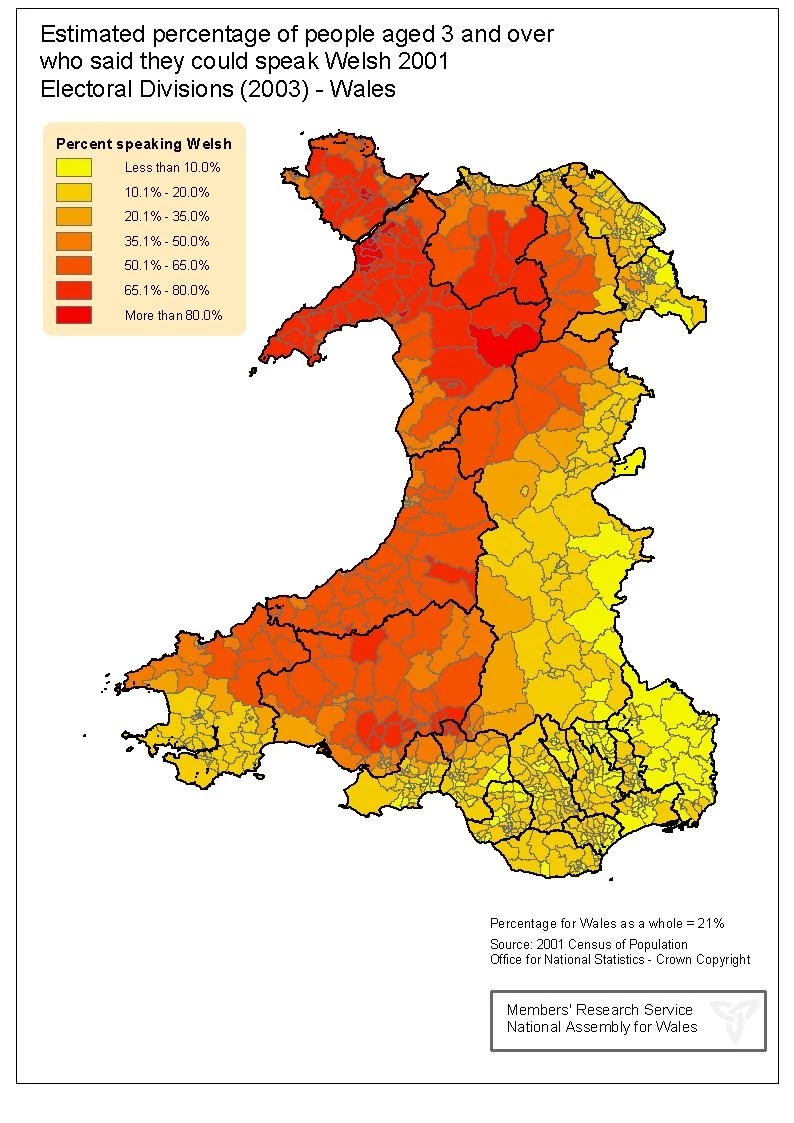The Welsh language today
A success story?
Like many minority languages, Welsh has had to struggle for survival. It was one of the first languages to be threatened by the spread of English across the globe. Only a fifth of the population of Wales is able to speak the language. Apart from some very young children, everyone who speaks Welsh in Wales can also speak English.
However, in terms of endangered languages Welsh is very much a success story. The 2001 census showed that, for the first time in over a century, the number and the percentage of Welsh speakers are actually increasing. In 1991 there were 508,000 speakers or 18.7% of the population. In 2001 that number had increased to 582,000 speakers, representing 20.8% of the total population.
Paradoxes
Map showing distribution of Welsh speakers, 2001 census.
There are some interesting paradoxes: the regions where there are high percentages of Welsh speakers aren’t necessarily the places where the greatest number of Welsh speakers live. For example, you’re more likely to hear Welsh spoken in the west of the country than in the east. In Gwynedd, 69% of the population are Welsh-speaking, while in Cardiff only 11% can speak the language. However, more Welsh speakers live in the cities and towns than in the countryside and there are more Welsh speakers in the south than in the north. The number of Welsh speakers in Gwynedd, for example, is around 78,000. This is actually less than Carmarthenshire, where only half of the population is Welsh-speaking, but the total number is 84,000. While there has been an increase in the percentage of Welsh speakers in anglicised areas such as Cardiff, there has been a decrease in the number of electoral divisions where over 80% of the inhabitants can speak Welsh.
The two main factors that have led to the encouraging upturn in the number of Welsh speakers have been the success of Welsh-medium schools and the growth in the number of adults who are learning the language. For the third time in succession, census results have shown an increase in the number of young people speaking Welsh. 26% of people under 35 can speak Welsh — an increase of 9% since 1991.
There are also Welsh speakers living outside Wales. Surveys commissioned by S4C, the Welsh television channel, estimate that there are more than 200,000 Welsh speakers living in England. There is a Welsh colony in the Chubut province of Argentina where some of the descendants of the original 19th-century settlers are bilingual in Welsh and Spanish.
Example: a Welsh speaker from Caernarfon
Gwil Pritchard introduces himself in Welsh.
This is a video clip of Gwil Pritchard, a young Welsh speaker from Caernarfon, Gwynedd in north-west Wales speaking in his local dialect. Although he is bilingual in English and Welsh, Welsh is still very much the majority language of the community in which he lives.
In the next chapter you can hear him talk about his linguistic background and dialect differences between Caernarfon and nearby Bangor, with a translation provided in English. Known as ‘Cofi’ Welsh, the speech of Caernarfon town is a rare example of a Welsh-language urban dialect.
Caernarfon Welsh — an urban dialect
Gwil Pritchard talks about Caernarfon Welsh.
I grew up in Caernarfon. The language of the home was Welsh. That was true of the area around Caernarfon too. The people we knew in that area, friends and family, they all spoke Welsh. The same thing was true in the schools too — primary schools, secondary school, everything was in Welsh. Living in Caernarfon, you get the feeling that in a way it’s a language of its own. Just the accent and the little words you use are different to other places. Other people notice that too, when you talk to them.
The difference between Bangor and Caernarfon to start with. They’re only nine miles apart, but in Bangor they’re famous for their 'ayes', because they say 'aye' after everything. In Caernarfon it’s 'ia' after everything. And when I say after everything, I mean everything. This is the kind of thing people say — “You going out tonight?” – instead of replying 'ia', they’d have to say “'Ia, ia?'”
